
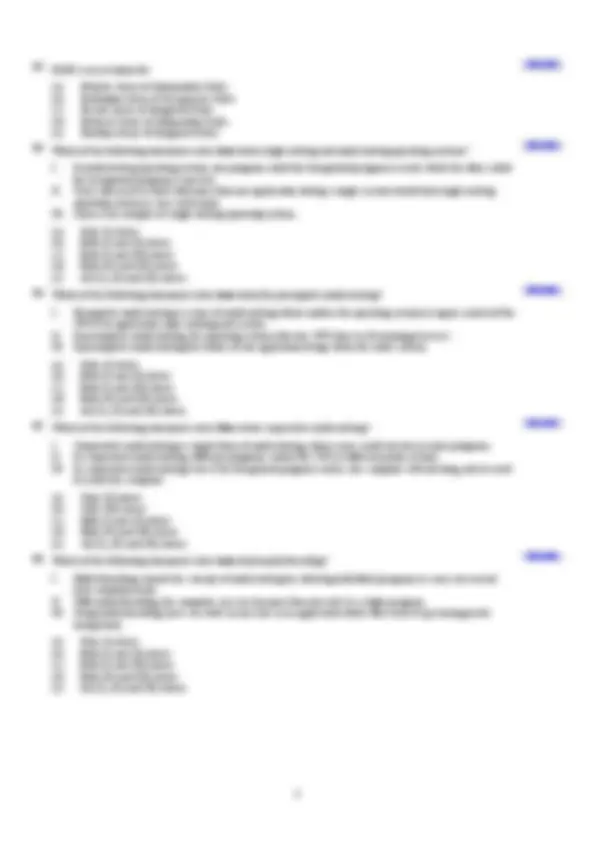
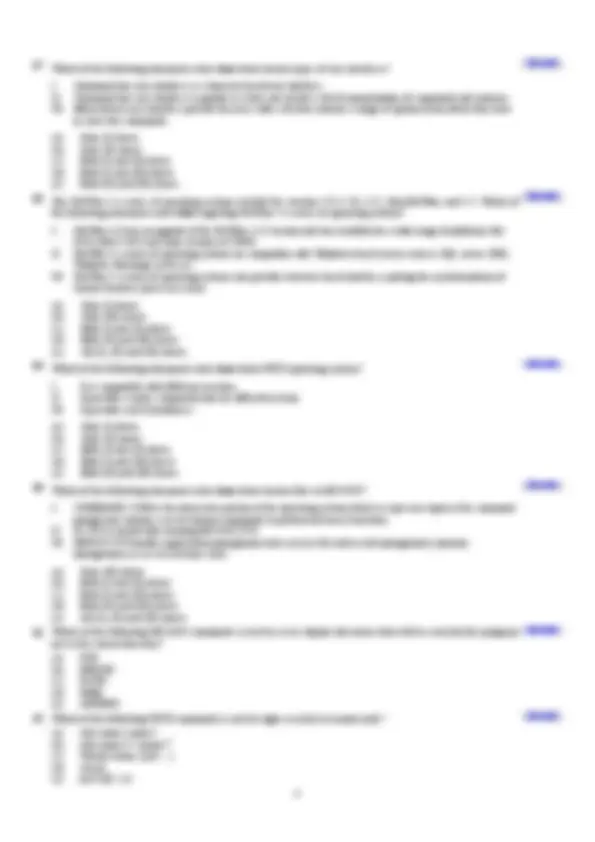
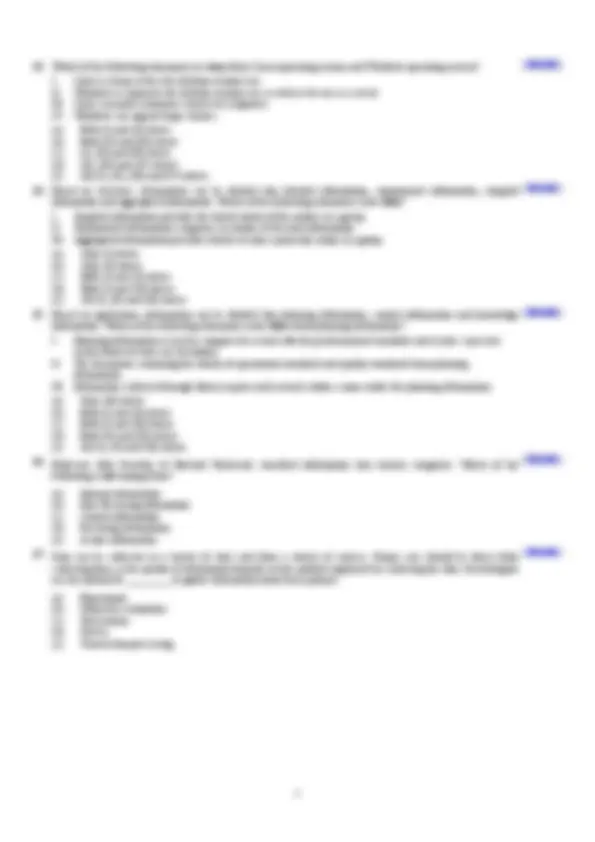
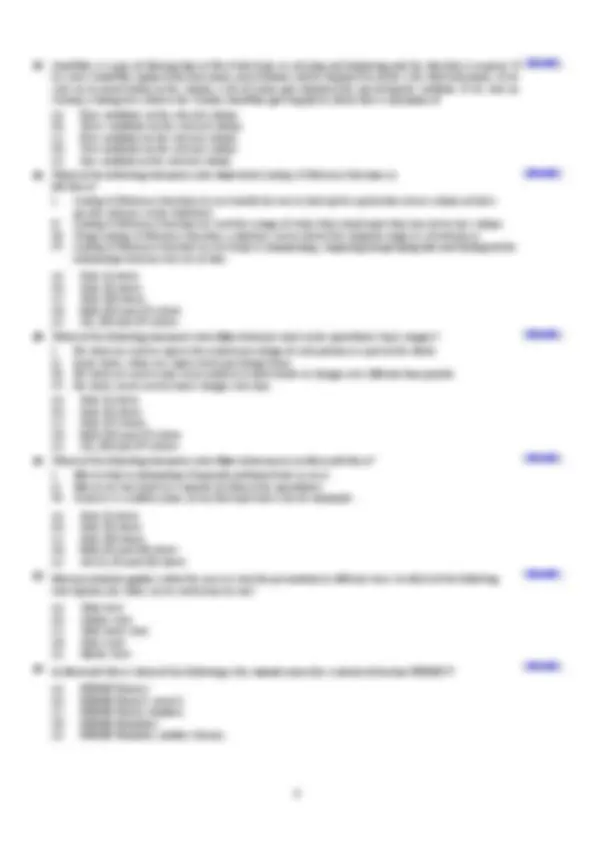
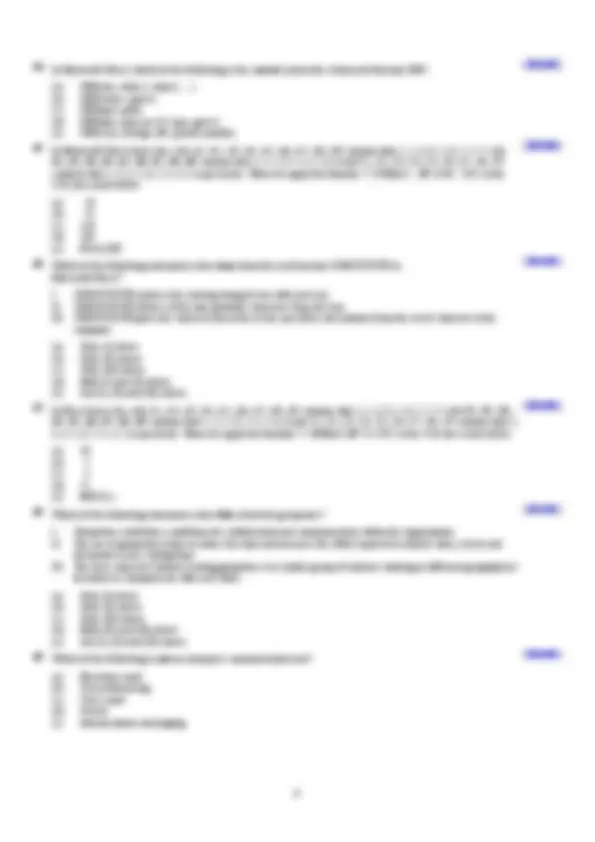
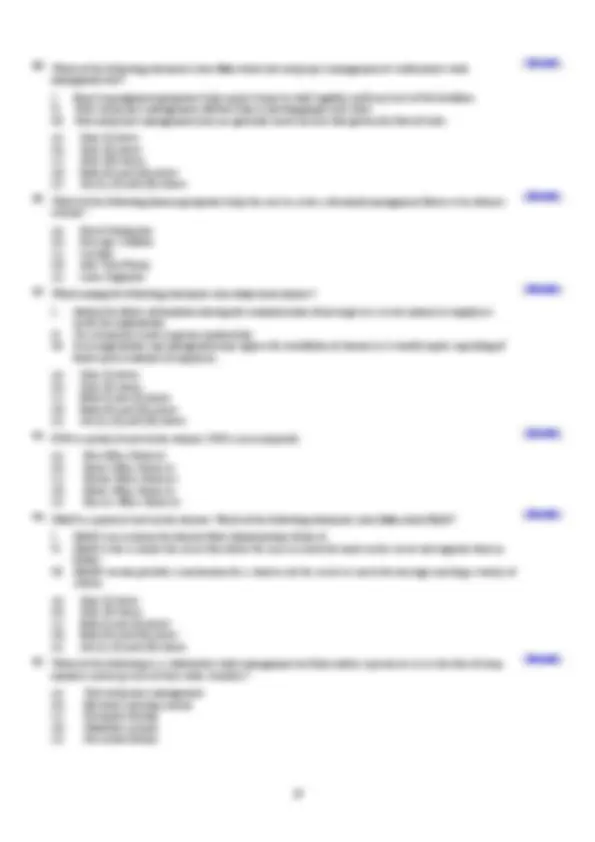
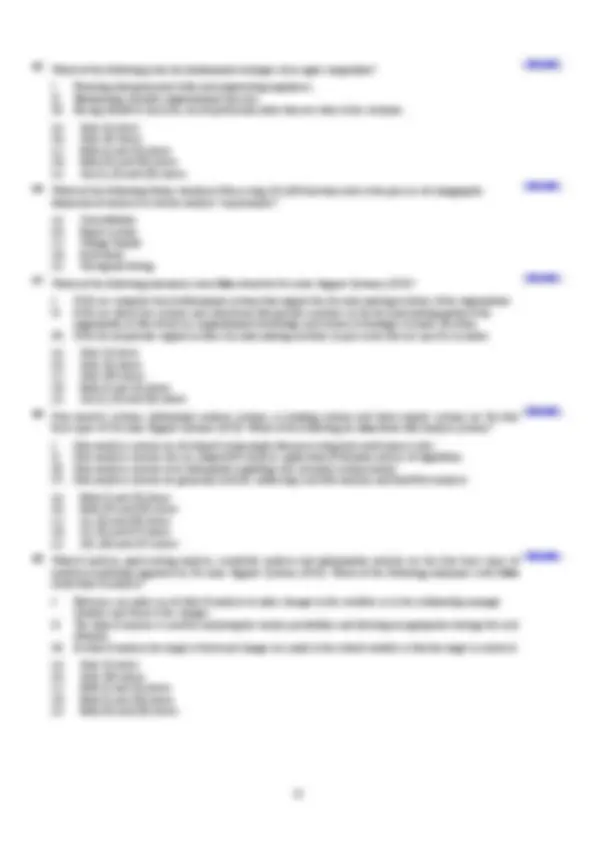
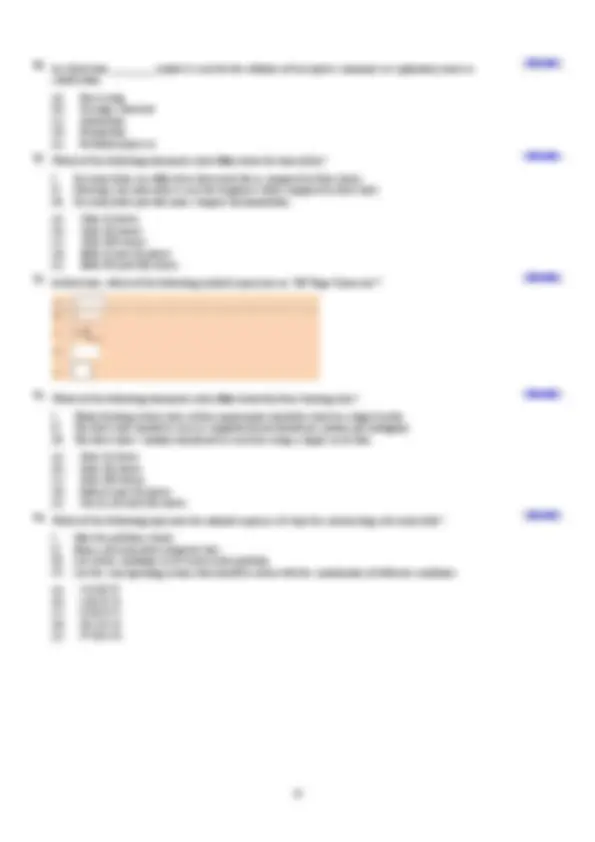
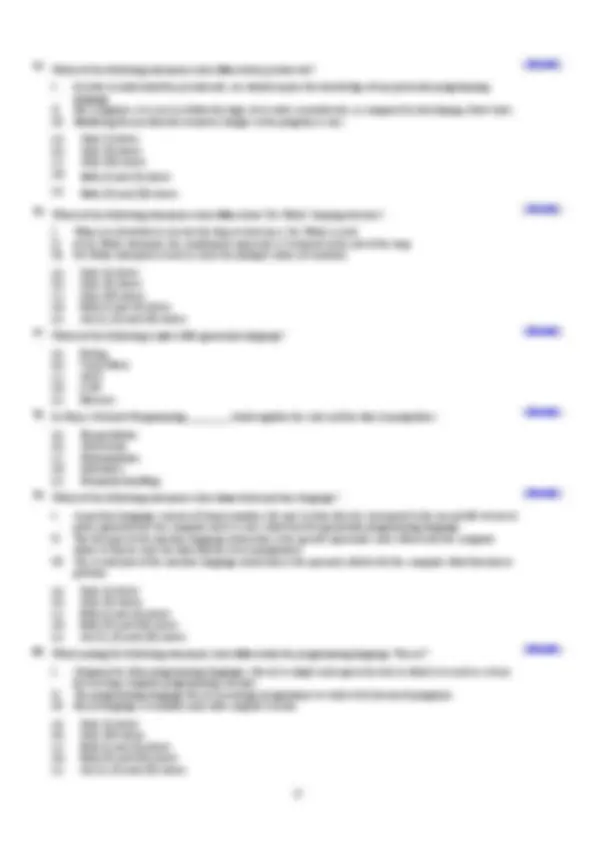
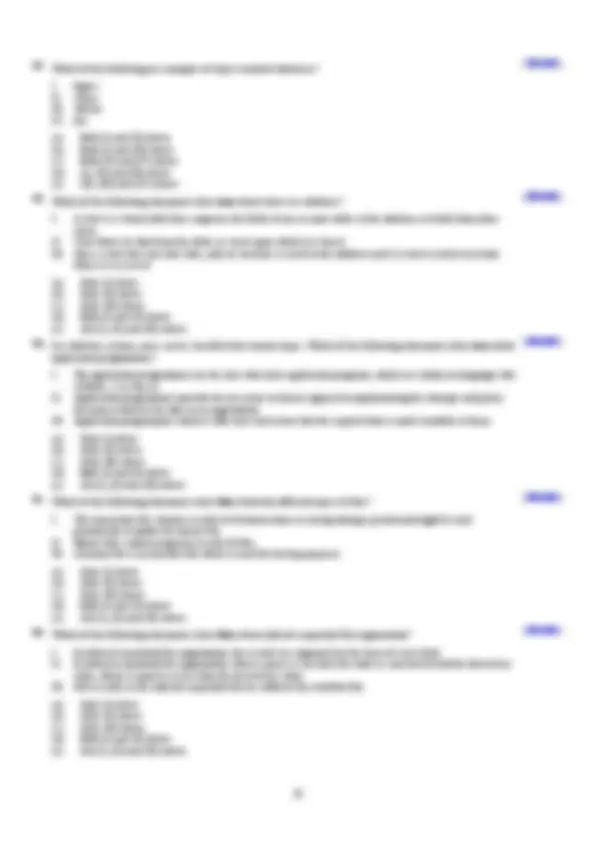
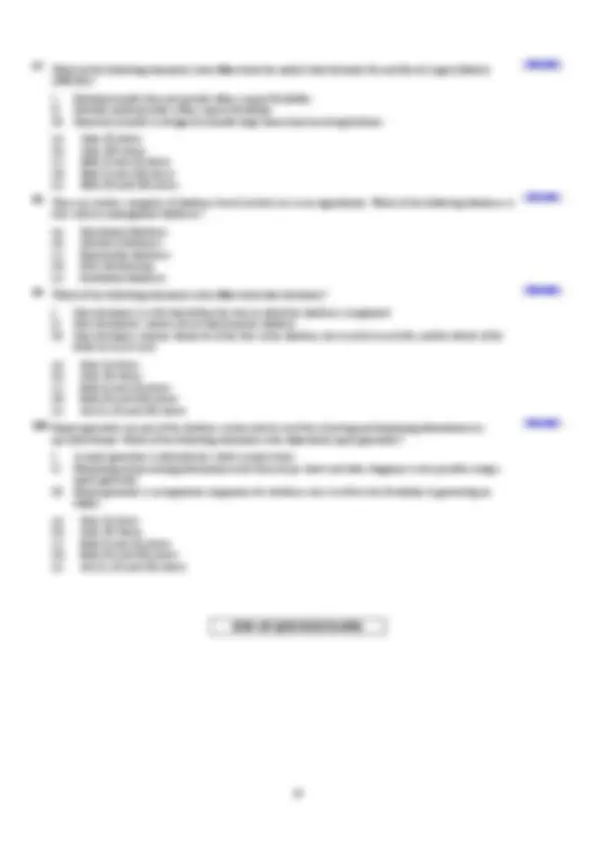
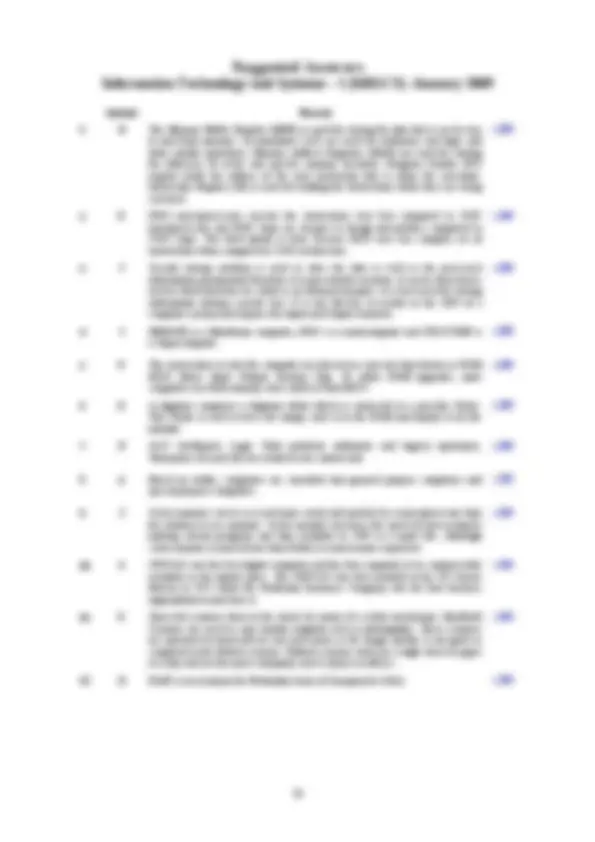
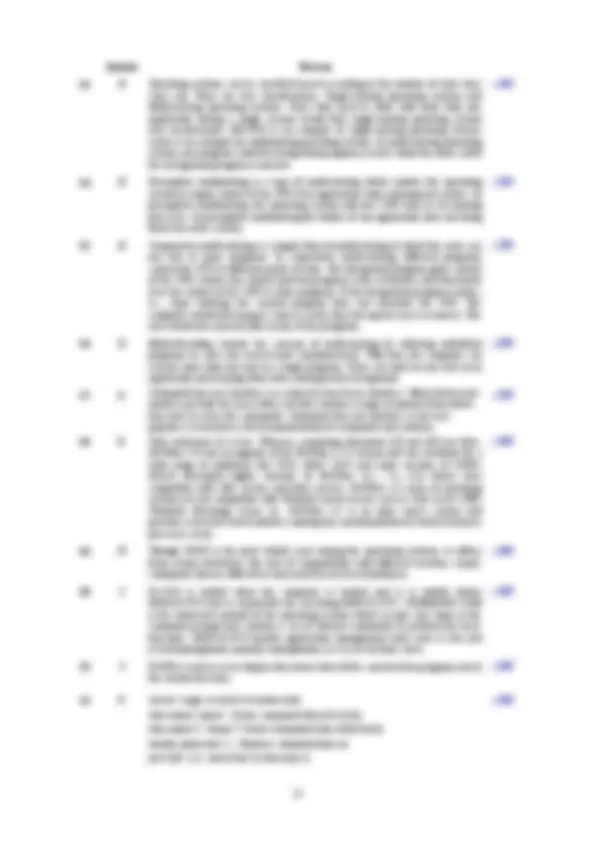
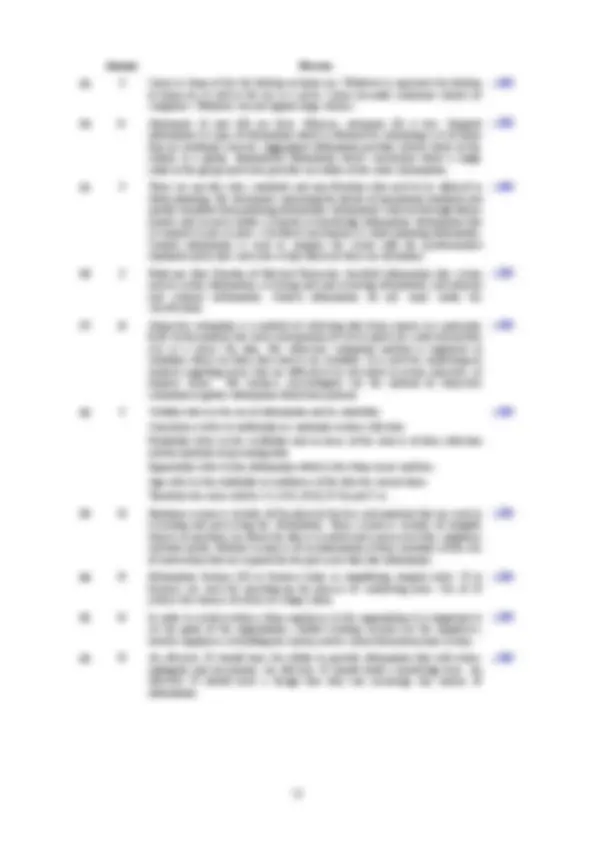
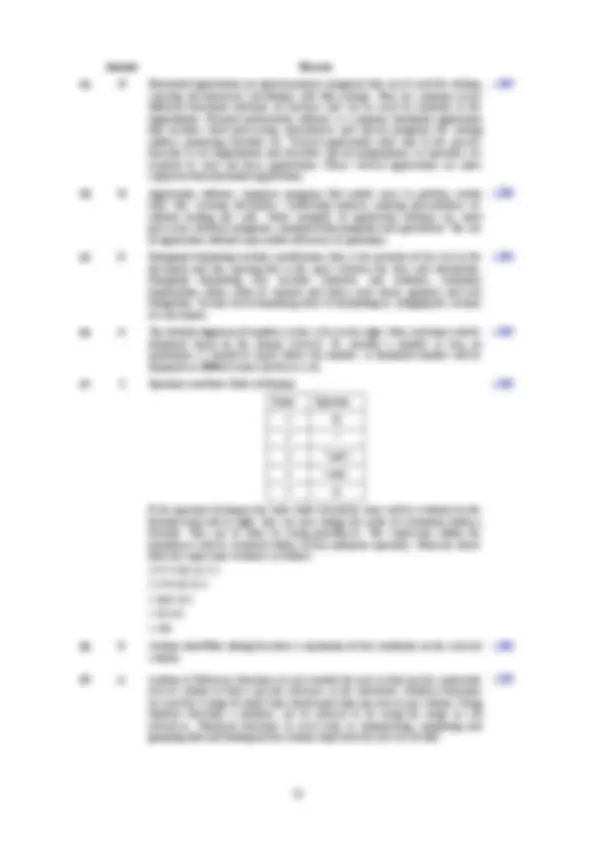
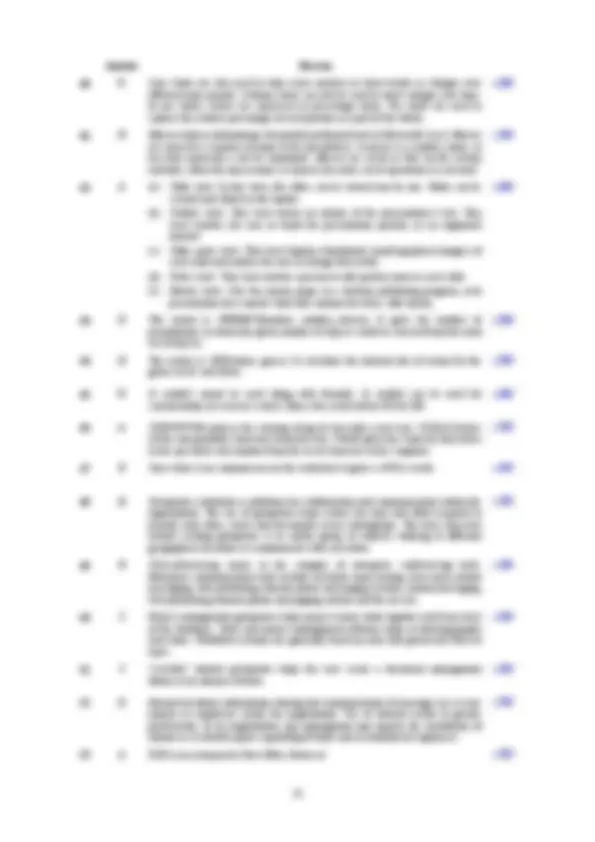
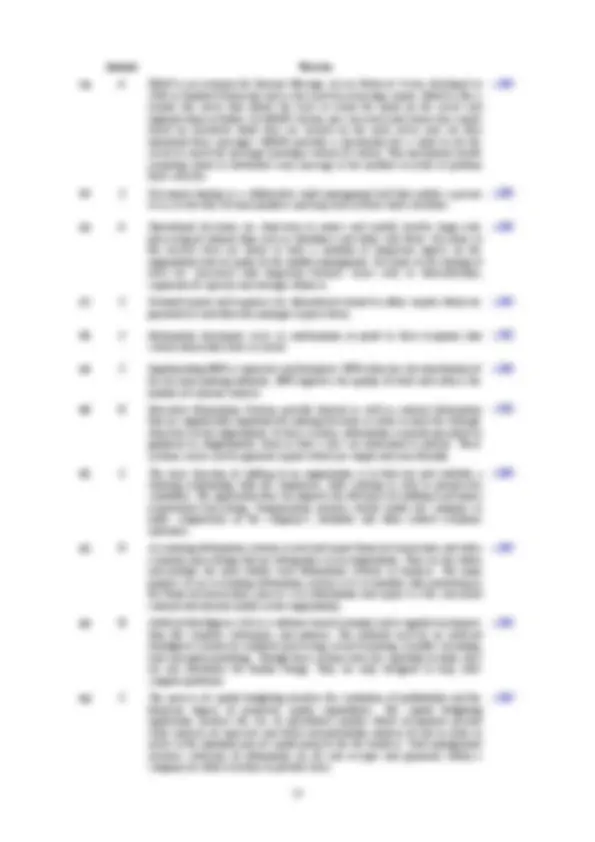
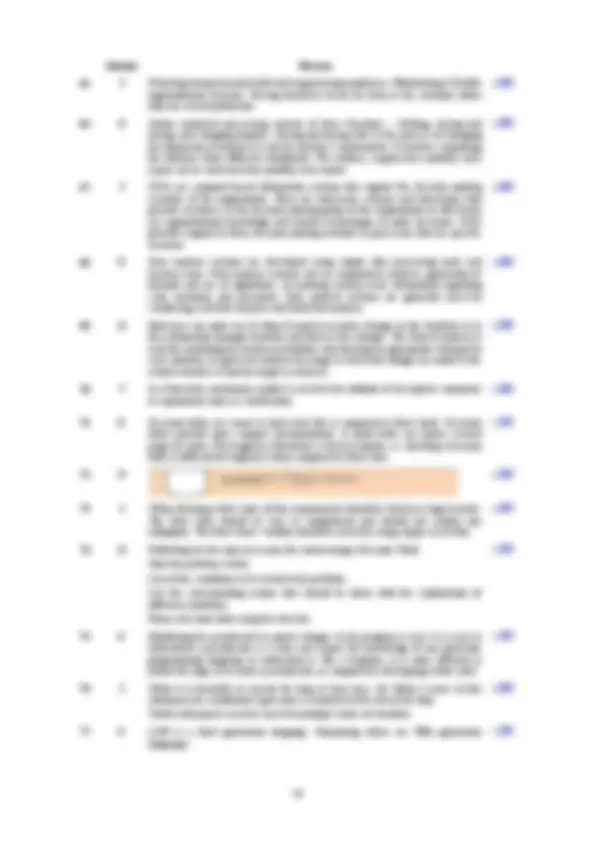
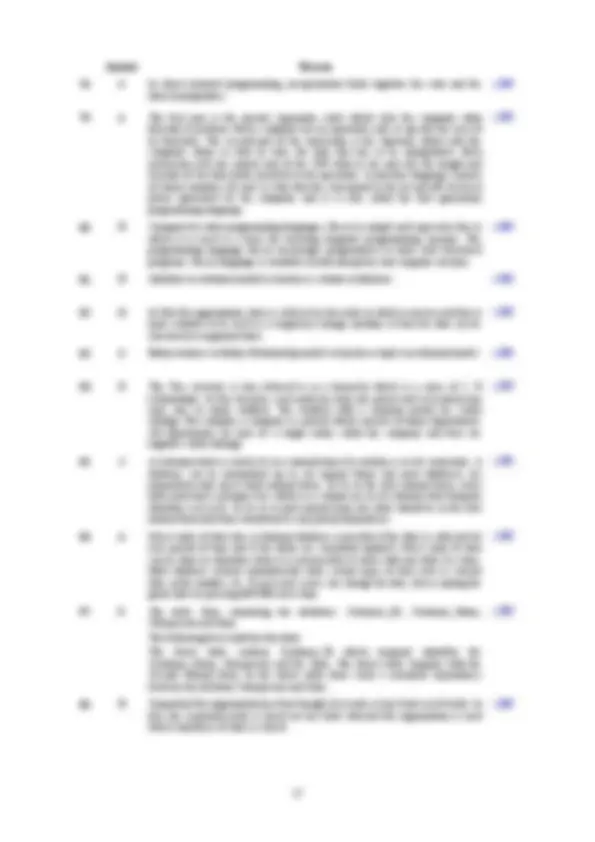
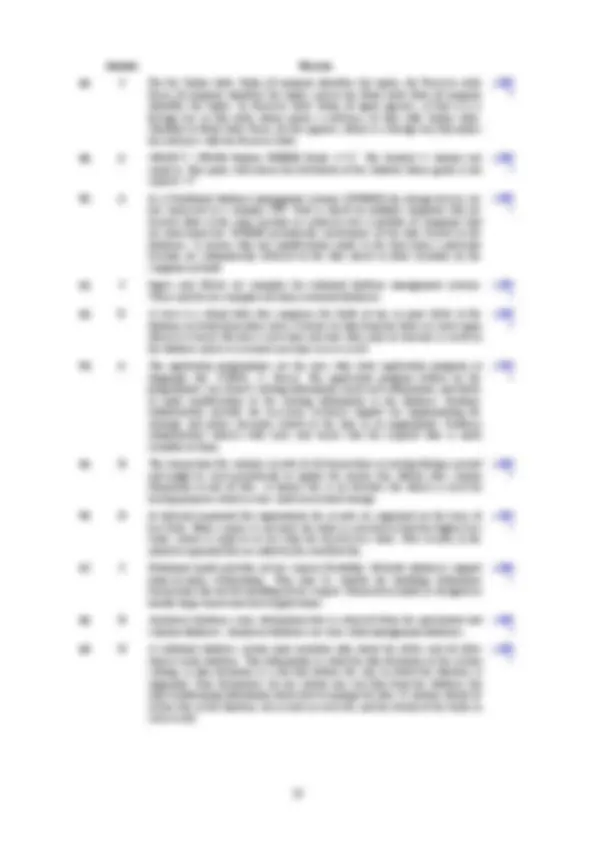



Study with the several resources on Docsity

Earn points by helping other students or get them with a premium plan


Prepare for your exams
Study with the several resources on Docsity

Earn points to download
Earn points by helping other students or get them with a premium plan
Community
Ask the community for help and clear up your study doubts
Discover the best universities in your country according to Docsity users
Free resources
Download our free guides on studying techniques, anxiety management strategies, and thesis advice from Docsity tutors
A computer quiz covering various topics including types of computers, memory, multi-threading, user interfaces, and information management. It includes multiple-choice questions on topics such as computer classification, memory types, raid, multi-threading concepts, user interface types, and information division. The quiz also includes questions on specific software and operating systems like ms-dos, linux, and netware.
Typology: Study notes
1 / 29

This page cannot be seen from the preview
Don't miss anything!






















Answer all 100 questions. Each question carries one mark.
1. (^) Which of the following type of registers is used for storing the data that is on its way to and from memory?
(a) Accumulator (AC) (b) Memory Buffer Register (MBR) (c) Program Counter (PC) (d) Instruction Register (IR) (e) Memory Address Register (MAR).
2. (^) Which of the following statements is/are true about Reduced Instruction Set Computer (RISC) processor?
I. RISC microprocessors execute the instructions very fast when compared to Complex Instruction Set Computer (CISC) microprocessors. II. RISC chips are cheaper to design and produce compared to CISC chips. III. RISC uses more complex set of instructions when compared to CISC architecture.
(a) Only (I) above (b) Only (II) above (c) Only (III) above (d) Both (I) and (II) above (e) Both (II) and (III) above.
3. (^) Which of the following statements is/are false about secondary storage media?
I. Secondary storage media is known as external memory. II. Secondary storage media is non-volatile in nature and is slower than the primary storage media. III. Secondary storage media is directly accessible to CPU of a computer system.
(a) Only (I) above (b) Only (II) above (c) Only (III) above (d) Both (I) and (II) above (e) Both (II) and (III) above.
4. (^) Match the following: 1. IBM4300 a. Mainframe computer 2. PDP-1 b. Supercomputer 3. CRAYXMP c. Minicomputer
(a) 1-a, 2-b, 3-c (b) 1-b, 2-a, 3-c (c) 1-a, 2-c, 3-b (d) 1-c, 2-a, 3-b (e) 1-c, 2-b, 3-a.
5. (^) The instructions to start the computer are placed on a special chip known as Read Only Memory Basic Input-Output
System (ROM BIOS) chip. To allow Read Only Memory (ROM) upgrades, most computers use
(a) Dynamic Random Access Memory (b) Video Random Access Memory (c) Cache Memory (d) Flash Memory (e) Virtual Memory.
6. (^) In digitizer, which of the following is connected to a pen-like stylus that is used to trace the image, store it in the
random access memory and display it on monitor?
(a) Charge coupled device (b) Switch (c) Joystick (d) Digitizer tablet (e) Keyboard encoder.
7. (^) Which of the following statements is/are false about Arithmetic Logic Unit (ALU)?
I. ALU performs arithmetic and logical operations on the data. II. ALU obtains the program instructions stored in the primary memory of the computer, interprets them and issues signals that result in their execution. III. ALU is designed to store the data generated at various stages of processing.
(a) Only (I) above (b) Only (II) above (c) Only (III) above (d) Both (I) and (III) above (e) Both (II) and (III) above.
8. (^) Computers can be broadly classified on the basis of their utility, technology, size and capacity. Based on utility,
computers are classified into
(a) General purpose computers and special purpose computers (b) Analog computers and digital computers (c) Hybrid computers and digital computers (d) Microcomputers and minicomputers (e) Minicomputers and supercomputers.
9. (^) Which of the following statements is/are false about cache memory?
I. Cache memory can be accessed more easily and quickly by a microprocessor than the random access memory. II. Cache memory increases the speed of processing by making current programs and data available to CPU at a rapid rate. III. Cache memory is less expensive compared to random access memory.
(a) Only (I) above (b) Only (II) above (c) Only (III) above (d) Both (I) and (III) above (e) Both (II) and (III) above.
10. (^) Which of the following is the first business organization to purchase Universal Automatic Computer (UNIVAC)?
(a) Prudential insurance company (b) Life insurance corporation (c) World bank (d) Housing and financial development bank (e) US stock exchange.
11. (^) Which of the following statements is/are false about flatbed scanners?
I. Flatbed scanners draw in the sheets by means of a roller mechanism. II. Flatbed scanners work on a single sheet of paper at a time and are the most commonly used scanners in offices. III. Flatbed scanners are used to copy smaller originals such as photographs and the image quality is not good as compared to the handheld scanners.
(a) Only (I) above (b) Only (II) above (c) Only (III) above (d) Both (I) and (III) above (e) Both (II) and (III) above.
17. (^) Which of the following statements is/are true about various types of user interfaces?
I. Command-line user interface is a character-based user interface. II. Command-line user interface is popular as it does not involve a lot of memorization of commands and syntaxes. III. Menu-driven user interface provide the users with a list that contains a range of options from which they have to select the commands.
(a) Only (I) above (b) Only (II) above (c) Both (I) and (II) above (d) Both (I) and (III) above (e) Both (II) and (III) above.
18. (^) The NetWare 4.x series of operating systems include the versions 4.0, 4.10, 4.11, IntraNetWare and 4.2. Which of
the following statements is/are false regarding NetWare 4.x series of operating systems?
I. NetWare 4.0 was an upgrade of the NetWare 3.12 version and was available for a wide range of platforms like DOS, MAC OS/2 and some versions of UNIX. II. NetWare 4.x series of operating systems are compatible with Windows-based servers such as SQL server 2000, Windows Exchange server etc. III. NetWare 4.x series of operating systems also provides browser-based interface, making the synchronization of various business processes easier.
(a) Only (I) above (b) Only (III) above (c) Both (I) and (II) above (d) Both (II) and (III) above (e) All (I), (II) and (III) above.
19. (^) Which of the following statements is/are true about UNIX operating system?
I. It is compatible with different versions. II. It provides cryptic commands that are difficult to learn. III. It provides user-friendliness.
(a) Only (I) above (b) Only (II) above (c) Both (I) and (II) above (d) Both (I) and (III) above (e) Both (II) and (III) above.
20. (^) Which of the following statements is/are true about various files in MS-DOS?
I. COMMAND.COM is the interactive portion of the operating system which accepts user input at the command prompt and contains a set of internal commands to perform the basic functions. II. IO.SYS is loaded after loading MS-DOS.SYS. III. MSDOS.SYS handles application management tasks such as file and record management, memory management, access to real time clock.
(a) Only (III) above (b) Both (I) and (II) above (c) Both (I) and (III) above (d) Both (II) and (III) above (e) All (I), (II) and (III) above.
21. Which of the following MS-DOS commands is used to set or display directories that will be searched for programs not in the current directory? (a) DIR (b) MKDIR (c) PATH (d) REM (e) APPEND.
22. Which of the following UNIX commands is used to login securely to remote node?
(a) alias name1 name (b) alias name1= “name2” (c) Unalias name1 [na2…] (d) ssh nd (e) mv f1[f2..] d.
23. Which of the following statements are true about Linux operating system and Windows operating system?
I. Linux is cheap or free for desktop or home use. II. Windows is expensive for desktop or home use as well as for use as a server. III. Linux can make enormous clusters of computers. IV. Windows can support large clusters. (a) Both (I) and (II) above (b) Both (II) and (III) above (c) (I), (II) and (III) above (d) (II), (III) and (IV) above (e) All (I), (II), (III) and (IV) above.
24. Based on structure, information can be divided into detailed information, summarized information, sampled information and aggregated information. Which of the following statements is/are false? I. Sampled information provides the details about all the entities in a group. II. Summarized information comprises an outline of the total information. III. Aggregated information provides details of only a particular entity in a group. (a) Only (I) above (b) Only (II) above (c) Both (I) and (II) above (d) Both (I) and (III) above (e) All (I), (II) and (III) above.
25. Based on application, information can be divided into planning information, control information and knowledge information. Which of the following statements is/are false about planning information? I. Planning information is used to compare the actual with the predetermined standards and to take corrective action wherever there are deviations. II. The documents containing the details of operational standards and quality standards form planning information. III. Information collected through library reports and research studies comes under the planning information. (a) Only (III) above (b) Both (I) and (II) above (c) Both (I) and (III) above (d) Both (II) and (III) above (e) All (I), (II) and (III) above.
26. (^) Professor John Dearden of Harvard University classified information into various categories. Which of the
following is not among them?
(a) Internal information (b) Non-Recurring information (c) Control information (d) Recurring information (e) Action information.
27. (^) Data can be collected in a variety of ways and from a variety of sources. Proper care should be taken while
collecting data, as the quality of information depends on the method employed for collecting the data. Psychologists use the method of _________ to gather information about their patients.
(a) Experiment (b) Subjective estimation (c) Observation (d) Survey (e) Transaction processing.
33. (^) Applications are classified into vertical and horizontal applications. Which of the following statements is/are false
about horizontal applications?
I. Horizontal applications are general purpose programs that can be used for writing, carrying out numerical calculations, and data storage. II. Horizontal applications are common across different functional divisions of business and can be used by anybody in the organization. III. Personal productivity software is a popular horizontal application that includes word processing, spreadsheets and special programs for storing address, preparing schedules etc. IV. Horizontal applications are expensive when compared to vertical applications.
(a) Only (I) above (b) Only (IV) above (c) Both (I) and (IV) above (d) (I), (II) and (III) above (e) All (I), (II), (III) and (IV) above.
34. (^) Which of the following statements is/are false about application software?
I. Application software comprises programs that enable users to perform certain tasks like creating documents, conducting analysis, making presentations etc. without writing any code. II. Some examples of application software are word processors, database programs, communication programs and spreadsheet. III. The use of application software will not enable efficiency in operations.
(a) Only (I) above (b) Only (III) above (c) Both (I) and (II) above (d) Both (II) and (III) above (e) All (I), (II) and (III) above.
35. (^) Which of the following statements is/are true about paragraph formatting in word processing?
I. Paragraph formatting includes justification, that is the position of the text in the document and line spacing that is the space between the lines and indentation. II. Paragraph formatting also includes footnotes and endnotes, automatic hyphenation, tables, table of contents and index, style sheets, graphics and web integration. III. Paragraph formatting refers to formatting or changing the sections in a document.
(a) Only (I) above (b) Only (II) above (c) Only (III) above (d) Both (I) and (II) above (e) All (I), (II) and (III) above.
36. (^) In Microsoft-Excel, which of the following statements is/are false about spreadsheet data type ‘numbers’?
I. The default alignment of numbers in the cell is to the left. II. To consider a number as text, an apostrophe (‘) should be typed before the number. III. A formatted number will be displayed as #### if it does not fit in a cell.
(a) Only (I) above (b) Only (II) above (c) Both (I) and (II) above (d) Both (I) and (III) above (e) Both (II) and (III) above.
37. (^) In MS-Excel, the formula = 32^23/2&2^2 would give the result as
(a) 76 (b) 72 (c) 184 (d) 13. (e) Displays an error message.
38. AutoFilter is a type of filtering data in Excel that helps in selecting and displaying only the data that is required. If we select AutoFilter option from Data menu, arrow buttons will be displayed in all the cells with field names. If we click on an arrow button in the column, a list of values gets displayed for specifying the condition. If we click on Custom, a dialog box called as the Custom AutoFilter gets displayed, which takes a maximum of (a) Four conditions on the selected column (b) Three conditions on the selected column (c) Five conditions on the selected column (d) Two conditions on the selected column (e) One condition on the selected column. 39. Which of the following statements is/are^ true^ about Lookup & Reference functions in MS-Excel? I. Lookup & Reference functions in excel enable the user to look up for a particular row or column or find a specific reference in the worksheet. II. Lookup & Reference functions are used for a range of values that extend more than one row or one column. III. Using Lookup & Reference functions, a database can be referred by using the range or cell references. IV. Lookup & Reference functions in excel help in summarizing, comparing and grouping data and finding out the relationships between two sets of data.
(a) Only (I) above (b) Only (II) above (c) Only (III) above (d) Both (III) and (IV) above (e) (II), (III) and (IV) above.
40. Which of the following statements is/are false about pie charts in the spreadsheet chart category?
I. Pie charts are used to express the relative percentage of each portion as a part of the whole. II. In pie charts, values are expressed in percentage terms. III. Pie charts are used in time series analysis to show trends or changes over different time periods. IV. Pie charts can be used to show changes over time. (a) Only (I) above (b) Only (II) above (c) Only (IV) above (d) Both (III) and (IV) above (e) (II), (III) and (IV) above.
41. Which of the following statements is/are false about macros in Microsoft-Excel?
I. Macros help in automating a frequently performed task in excel. II. Macros are not stored in a separate location in the spreadsheet. III. A macro is a symbol, name, or key that represents a list of commands.
(a) Only (I) above (b) Only (II) above (c) Only (III) above (d) Both (II) and (III) above (e) All (I), (II) and (III) above.
42. (^) Most presentation graphics allow the users to view the presentation in different ways. In which of the following
view options, the slides can be viewed one by one?
(a) Slide view (b) Outline view (c) Slide sorter view (d) Notes view (e) Master view.
43. (^) In Microsoft-Excel, which of the following is the correct syntax for a statistical function PERMUT?
(a) PERMUT(array) (b) PERMUT(array1, array2) (c) PERMUT(array, number) (d) PERMUT(number) (e) PERMUT(number, number chosen).
50. (^) Which of the following statements is/are false about task and project management of collaborative work
management tool?
I. Project management groupware helps project teams to work together and keep track of the deadlines. II. Tasks and project management software help in drawing graphs and charts. III. Task and project management tools are generally based on rules that govern the flow of tasks.
(a) Only (I) above (b) Only (II) above (c) Only (III) above (d) Both (II) and (III) above (e) All (I), (II) and (III) above.
51. (^) Which of the following intranet groupware helps the user to create a document management library at an intranet
website?
(a) Novell Groupwise (b) Netscape Collabra (c) Livelink (d) Alta Vista Forum (e) Lotus Organizer.
52. (^) Which among the following statements is/are true about intranet?
I. Intranet facilitates information sharing and communication of messages in a secure manner to employees inside the organization. II. Use of intranet results in greater productivity. III. In an organization, top management may oppose the installation of intranet as it would require expending of funds and recruitment of employees.
(a) Only (I) above (b) Only (II) above (c) Both (I) and (II) above (d) Both (II) and (III) above (e) All (I), (II) and (III) above.
53. (^) POP is a protocol used on the internet. POP is an acronym for
(a) Post Office Protocol (b) Power Office Protocol (c) Private Office Protocol (d) Public Office Protocol (e) Process Office Protocol.
54. (^) IMAP is a protocol used on the internet. Which of the following statements is/are false about IMAP?
I. IMAP is an acronym for Internet Mail Administration Protocol. II. IMAP is like a remote file server that allows the users to retain the mails on the server and organize them in folders. III. IMAP4 version provides a mechanism for a client to ask the server to search for messages meeting a variety of criteria.
(a) Only (I) above (b) Only (II) above (c) Both (I) and (II) above (d) Both (II) and (III) above (e) All (I), (II) and (III) above.
55. (^) Which of the following is a collaborative work management tool that enables a person to access the files of team
members and keep track of their work schedules?
(a) Task and project management (b) Electronic meeting systems (c) Document sharing (d) Workflow systems (e) Discussion forums.
56. (^) Which of the following statements is/are true about decisions taken by the management at different levels?
I. Operational decisions are short-term in nature and usually involve large-scale processing of internal data such as attendance and daily cash flows. II. Decisions at the strategical level are likely to have a medium to long-term impact on the organization and are made by the middle management. III. Decisions at the tactical level are concerned with long-term business issues such as diversification, expansion of capacity and strategic alliances.
(a) Only (I) above (b) Only (II) above (c) Only (III) above (d) Both (I) and (III) above (e) All (I), (II) and (III) above.
57. (^) Management Information Systems (MIS) helps in generating a variety of reports that are useful to managers through
the management reporting systems. Which of the following reports are alternatively termed as adhoc reports which are generated as and when the manager requires them?
(a) Periodic scheduled reports (b) Exception reports (c) Demand reports and responses (d) Push reports (e) Edit reports.
58. (^) Documents that are generated by the transaction processing systems are known as transaction documents and that
can be divided into various categories. Which of the following documents serve as confirmation or proof to their recipients that certain transactions have occurred?
(a) Turnaround documents (b) Action documents (c) Information documents (d) Edit reports (e) Control listings.
59. (^) Business Process Re-engineering (BPR) refers to radically changing the design of business processes to improve the
performance and efficiency. Which of the following statements is/are true about BPR?
I. Implementing BPR is expensive and disruptive. II. BPR advocates decentralization of the decision-making authority. III. BPR improves the quality of work and increases the number of external contacts.
(a) Only (I) above (b) Only (II) above (c) Both (I) and (II) above (d) Both (II) and (III) above (e) All (I), (II) and (III) above.
60. (^) Executive Information Systems (EIS) is a computerized information system which is designed to meet the
informational requirements of the top executives of the organization. Which of the following statements is/are true about EIS?
I. These systems provide internal as well as external information that are significantly important for making decisions in order to meet the strategic objectives of the organization. II. In these systems, information is mostly presented in graphical or diagrammatic form so that a user can understand it quickly. III. These systems can be used to generate reports which are simple and user-friendly.
(a) Only (I) above (b) Only (II) above (c) Both (I) and (II) above (d) Both (II) and (III) above (e) All (I), (II) and (III) above.
65. (^) Which of the following is/are the fundamental strategies of an agile competition?
I. Fostering entrepreneurial skills and empowering employees. II. Maintaining a flexible organizational structure. III. Pricing should be based on cost of production rather than on value to the customer.
(a) Only (I) above (b) Only (II) above (c) Both (I) and (II) above (d) Both (II) and (III) above (e) All (I), (II) and (III) above.
66. (^) Which of the following Online Analytical Processing (OLAP) functions refer to the process of changing the
dimension of analysis to suit the analysts’ requirements?
(a) Consolidation (b) Expert system (c) Change display (d) Drill down (e) Slicing and dicing.
67. (^) Which of the following statements is/are false about the Decision Support Systems (DSS)?
I. DSSs are computer-based information systems that support the decision making activities of the organization. II. DSSs are interactive systems and subsystems that provide assistance to the decision making group of the organization to effectively use organizational knowledge and various technologies to make decisions. III. DSSs do not provide support to those decision making activities or processors that are specific in nature.
(a) Only (I) above (b) Only (II) above (c) Only (III) above (d) Both (I) and (II) above (e) All (I), (II) and (III) above.
68. (^) Data analysis systems, information analysis systems, accounting systems and status inquiry systems are the four
basic types of Decision Support Systems (DSS). Which of the following are true about data analysis systems?
I. Data analysis systems are developed using simple data processing tools and business rules. II. Data analysis systems rely on comparative analysis, application of formula and use of algorithms. III. Data analysis systems track information regarding cash, inventory and personnel. IV. Data analysis systems are generally used for conducting cash flow analysis and fund flow analysis.
(a) Both (I) and (II) above (b) Both (II) and (III) above (c) (I), (II) and (III) above (d) (I), (II) and (IV) above (e) (II), (III) and (IV) above.
69. (^) What-if analysis, goal-seeking analysis, sensitivity analysis and optimization analysis are the four basic types of
analytical modeling supported by Decision Support Systems (DSS). Which of the following statements is/are false about what-if analysis?
I. End users can make use of what-if analysis to make changes in the variables or in the relationship amongst variables and observe the changes. II. The what-if analysis is used for analyzing the various possibilities and deriving an appropriate strategy for each situation. III. In what-if analysis the target is fixed and changes are made to the related variable so that the target is achieved.
(a) Only (I) above (b) Only (III) above (c) Both (I) and (II) above (d) Both (I) and (III) above (e) Both (II) and (III) above.
70. (^) In a flowchart, ________ symbol is used for the addition of descriptive comments or explanatory notes as
clarification.
(a) Processing (b) On page connector (c) Annotation (d) Preparation (e) Predefined process.
71. (^) Which of the following statements is/are false about decision tables?
I. Decision tables are difficult to draw and edit as compared to flow charts. II. Drawing a decision table is easy for beginners when compared to flow chart. III. Decision tables provide more compact documentation.
(a) Only (I) above (b) Only (II) above (c) Only (III) above (d) Both (I) and (II) above (e) Both (II) and (III) above.
72. (^) In flowchart, which of the following symbols represents an ‘Off Page Connector’?
I. While drawing a flow chart, all the requirements should be listed in a logical order. II. The flow chart should be easy to comprehend and should not contain any ambiguity. III. The flow charts’ validity should not be tested by using a simple set of data.
(a) Only (I) above (b) Only (II) above (c) Only (III) above (d) Both (I) and (II) above (e) All (I), (II) and (III) above.
74. (^) Which of the following represents the correct sequence of steps for constructing a decision table?
I. State the problem clearly. II. Form a decision table using two lists. III. List all the conditions to be tested in the problem. IV. List the corresponding actions that should be taken with the combination of different conditions.
(a) I-II-III-IV (b) I-III-IV-II (c) II-III-IV-I (d) III-I-IV-II (e) IV-III-I-II.
81. (^) Attribute in relational model is known as _________ in database.
(a) File (b) Column (c) Record (d) Table (e) Identifier.
82. (^) In which of the following file organization, data is collected in the order in which it arrives and that is more suitable
to be used as a temporary storage medium so that the data can be structured or organized later?
(a) Indexed (b) Pile (c) Sequential (d) Indexed-Sequential (e) Hashed.
83. (^) Entity instance in Entity-Relationship model is known as ________ in relational model.
(a) Tuple (b) Relation (c) Key (d) Row (e) Field.
84. Entity-Relationship model is based on various structures. Which of the following statements is/are^ true^ about tree structure? I. The tree structure is also referred to as a hierarchy, which is a series of 1: N relationships. II. In a tree structure, each node has only one parent and each parent has zero, one, or many children. III. In a tree structure, the children with a common parent are called siblings. (a) Only (I) above (b) Only (II) above (c) Both (I) and (II) above (d) Both (II) and (III) above (e) All (I), (II) and (III) above.
85. Which of the following statements is/are false about normal forms?
I. A relational table is said to be in a normal form if it satisfies a set of constraints. II. To be in the first normal form, every table must have a primary key, which is a column (or set of columns) that uniquely identifies each row. III. To be in the second normal form, there should not be any transitivity. (a) Only (I) above (b) Only (II) above (c) Only (III) above (d) Both (I) and (II) above (e) Both (II) and (III) above.
86. In relational database, data is entered either directly or through input forms or input screens. Which of the following statements is/are false about direct entry of data? I. Direct entry of data into a relational database is possible if the data is collected for an unlimited period of time and if the tables are not constantly updated. II. Direct entry of data can be done in situations when it is not possible to work with one table at a time. III. Most database systems directly enter certain types of data such as current date, order number, etc. (a) Only (I) above (b) Only (II) above (c) Both (I) and (II) above (d) Both (II) and (III) above (e) All (I), (II) and (III) above.
87. Consider the table Sales which contains the attributes: Customer_ID, Customer_Name, Salesperson and Zone. Which of the following statements is/are true about the given table? I. The above table does not comply with the first normal form. II. The above table complies with the second normal form. III. In the above table there exists a transitive dependency between the attributes Salesperson and Zone. IV. The above table contains Customer_ID which uniquely identifies the Customer_Name, Salesperson and Zone. (a) Only (I) above (b) Both (I) and (II) above (c) (I), (II) and (III) above (d) (II), (III) and (IV) above (e) All (I), (II), (III) and (IV) above. 88. (^) Which of the following statements is/are false about sequential file organization?
I. It has fixed length of records. II. It has fixed set of fields. III. In this, the sequential order is based on key field. IV. It is used where timeliness of data is critical.
(a) Only (I) above (b) Only (IV) above (c) Both (I) and (II) above (d) (II), (III) and (IV) above (e) All (I), (II), (III) and (IV) above.
89. (^) Consider following tables:
Sailors(Sailor_Id, Sailor_Name, Age, Grade) Reserves(Reser_Id, Sailor_Id, Reser_Date) Boats(Boat_Id, Reser_Id, Boat_Color) Which of the following are the foreign keys in the tables Reserves and Boats?
(a) Reser_Date, Boat_Id (b) Boat_Color, Sailor_Id (c) Sailor_Id, Reser_Id (d) Boat_Color, Reser_Date (e) Sailor_Id, Boat_Id.
90. (^) A Student table contains the following attributes: Stud_Id, Stud_name, Age and Grade. Which of the following SQL
queries display the entire students’ details whose grades are not equal to ‘C’?
(a) SELECT * FROM Student WHERE Grade<>‘C’; (b) SELECT Stud_Id, Stud_name FROM Student WHERE Grade<=‘C’; (c) SELECT Stud_Id, Stud_name FROM Student WHERE Grade>=‘C’; (d) SELECT * FROM Student WHERE Grade<‘C’; (e) SELECT * FROM Student WHERE Grade>‘C’;.
91. (^) Which of the following statements is/are false about the data storage in Distributed Database Management Systems
(DDBMS)?
I. In DDBMS, the storage devices are connected to a common CPU. II. The DDBMS periodically synchronize all the data located in the databases. III. DDBMS ensures that any modifications made to the data from a particular location are automatically reflected in the data stored at other locations on the computer network.
(a) Only (I) above (b) Only (II) above (c) Both (I) and (II) above (d) Both (II) and (III) above (e) All (I), (II) and (III) above.
97. (^) Which of the following statements is/are false about the models that fall under Record-Based Logical Models
(RBLMs)?
I. Relational model does not provide adhoc request flexibility. II. Network model provides adhoc request flexibility. III. Hierarchical model is designed to handle large transaction-based applications.
(a) Only (II) above (b) Only (III) above (c) Both (I) and (II) above (d) Both (I) and (III) above (e) Both (II) and (III) above.
98. (^) There are various categories of databases based on their use in an organization. Which of the following databases is
also called as management databases?
(a) Operational databases (b) Analytical databases (c) Hypermedia databases (d) Data warehousing (e) Distributed databases.
99. (^) Which of the following statements is/are false about data dictionary?
I. Data dictionary is a file that defines the way in which the database is organized. II. Data dictionaries contain all real data from the database. III. Data dictionary contains details of all the files in the database, the records in each file, and the details of the fields in each record.
(a) Only (I) above (b) Only (II) above (c) Both (I) and (II) above (d) Both (II) and (III) above (e) All (I), (II) and (III) above.
100. (^) Report generators are part of the database system and are used for retrieving and displaying information in a
specified format. Which of the following statements is/are true about report generators?
I. A report generator is alternatively called a report writer. II. Formatting and presenting information in the form of pie charts and other diagrams is also possible using a report generator. III. Report generator is an important component of a database since it reflects the flexibility in generating an output.
(a) Only (I) above (b) Only (II) above (c) Both (I) and (II) above (d) Both (II) and (III) above (e) All (I), (II) and (III) above.
Answer Reason
1. B The Memory Buffer Register (MBR) is used for storing the data that is on its way to and from memory. Accumulators (AC) are used for arithmetic and logic and other similar operations. Memory Address Registers (MAR) are used for storing the addresses of active and specific memory locations. Program Counter (PC) register holds the address of the next instruction that is inline for execution. Instruction Register (IR) is used for holding the Instructions while they are being executed.
< TOP
2. D^ RISC^ microprocessors^ execute the^ instructions^ very^ fast^ compared^ to^ CISC microprocessor and RISC chips are cheaper to design and produce compared to CISC chips. The third option is false because RISC uses less complex set of instructions when compared to CISC architecture.
< TOP
3. C^ Second storage^ medium is used to store the data as well as the processed information permanently therefore it is non-volatile in nature. It can be detached as well as fitted therefore its called as an External memory. It is best used for storing information during a power loss. It is not directly accessible to the CPU of a computer system and requires the Input and Output channels.
< TOP
4. C IBM4300 is a Mainframe computer, PDP-1 is a minicomputer and CRAYXMP is a Supercomputer.
< TOP
5. D^ The instructions to start the computer are placed on a special chip known as ROM BIOS (Basic Input /Output System) chip. To allow ROM upgrades, most computers use flash memory also called as flash BIOS.
< TOP
6. D A digitizer comprises a digitizer tablet which is connected to a pen-like Stylus. This Stylus is used to trace the image, store it in the RAM and display it on the monitor.
< TOP
7. E^ ALU^ (Arithmetic^ Logic^ Unit)^ performs^ arithmetic^ and^ logical^ operations. Statements (II) and (III) are related to the control unit.
< TOP
8. A Based on utility, computers are classified into general purpose computers and special purpose computers.
< TOP
9. C^ Cache memory can be accessed more easily and quickly by a microprocessor than the random access memory. Cache memory increases the speed of processing by making current programs and data available to CPU at a rapid rate. Although cache memory is much faster than RAM, it is much more expensive.
< TOP
10. A^ UNIVAC was the first digital computer and the first computer to be commercially available in the market place. The UNIVAC was first installed at the US Census Bureau in 1951 while the Prudential Insurance Company was the first business organization to purchase it.
< TOP
11. D^ Sheet fed scanners draw in the sheets by means of a roller mechanism. Handheld Scanners are used to copy smaller originals such as photographs. These scanners are operated by hand and are not used much as the image quality is not good as compared to the flatbed scanners. Flatbed scanners work on a single sheet of paper at a time and are the most commonly used scanners in offices.
< TOP
12. B RAID is an acronym for Redundant Array of Inexpensive Disks. < TOP